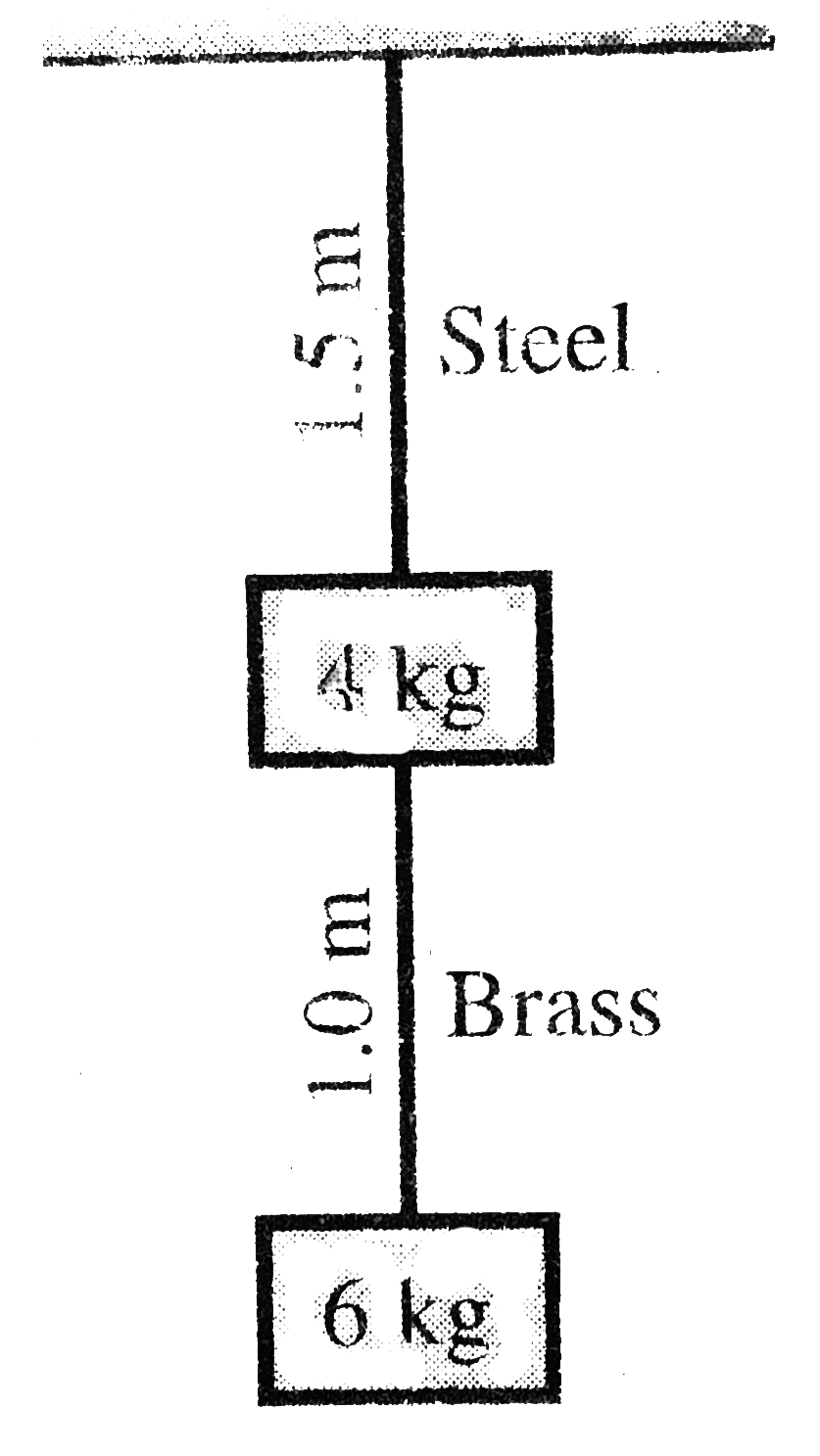A piece of steel wire (diameter = 0.075 cm and length 5.08 m) elongates by 0.7 cm due to a load of 12.7 kg. Find Young.s modulus of steel.
The correct Answer is:2.08×1011N/m2
To find Young's modulus of steel, we will use the formula:
Y=StressStrain
Step 1: Calculate the Stress
Stress is defined as the load applied per unit area.
1. Convert the load from kg to Newtons:
Load (F)=12.7kg×g=12.7kg×9.81m/s2≈124.5N
2. Calculate the cross-sectional area (A) of the wire:
The diameter of the wire is given as 0.075 cm, which we need to convert to meters:
Diameter=0.075cm=0.075×10−2m=0.00075m
The radius (r) is half of the diameter:
r=0.000752=0.000375m
Now, calculate the area using the formula for the area of a circle A=πr2:
A=π(0.000375)2≈3.14×(0.000375)2≈4.42×10−7m2
3. Calculate Stress:
Stress=FA=124.5N4.42×10−7m2≈2.82×108N/m2
Step 2: Calculate the Strain
Strain is defined as the change in length divided by the original length.
1. Convert the elongation from cm to meters:
Change in length=0.7cm=0.7×10−2m=0.007m
2. Calculate the original length in meters:
Original length=5.08m
3. Calculate Strain:
Strain=Change in lengthOriginal length=0.007m5.08m≈0.001376
Step 3: Calculate Young's Modulus
Now we can substitute the values of stress and strain into the formula for Young's modulus:
Y=StressStrain=2.82×108N/m20.001376≈2.05×1011N/m2
Final Answer
Thus, the Young's modulus of steel is approximately:
Y≈2.05×1011N/m2
Load (F)=12.7kg×g=12.7kg×9.81m/s2≈124.5N
The diameter of the wire is given as 0.075 cm, which we need to convert to meters:
Diameter=0.075cm=0.075×10−2m=0.00075m
The radius (r) is half of the diameter:
r=0.000752=0.000375m
Now, calculate the area using the formula for the area of a circle A=πr2:
A=π(0.000375)2≈3.14×(0.000375)2≈4.42×10−7m2
Stress=FA=124.5N4.42×10−7m2≈2.82×108N/m2
Change in length=0.7cm=0.7×10−2m=0.007m
Original length=5.08m
Strain=Change in lengthOriginal length=0.007m5.08m≈0.001376
Similar Questions
A steel wire of length 600cm and diameter 1.2 mm is stretched through 4 mm by a load. Calculate the work done. Young's modulus of steel =2×1011Nm−2.
View SolutionA wire of length 15m and diameter 4 mm elongates 0.3mm when stretched by weigth of 2.20kg. Calulate the Young's modulus of the material of the wire.
View SolutionFind the increment in the length of a steel wire of length 5m and radius 6mm under its own weight. Density of steel =8000kg/m3 and young's modulus of steel =2×1011N/m2. What is the energy stored in the wire ? (Take g =9.8m/s2)
View SolutionFind the work done in stretching a wire Im long and area of cross section 0.03 cm under a load of 100 N if Young.s modulus of the material of the wire is 2×1011N/m2
View SolutionIn searle's experiment, the diameter of the wire, as measured by a screw gauge of least count 0.001 cm is 0.500 cm. The length, measured by a scale of least count 0.1cm is 110.0cm. When a weight of 40N is suspended from the wire, its extension is measured to be 0.125 cm by a micrometer of least count 0.001 cm. Find the Young's modulus of the meterial of the wire from this data.
View SolutionA steel wire of length 4 m and diameter 5 mm is strethed by 5 kg-wt. Find the increase in its length, if the Young's modulus of steel is 2×1012 dyne cm2
View SolutionTwo wires of diameter 0.25cm, one made of steel and other made of brass, are loaded as shown in the figure. The unloaded length of the steel wire is 1.5m and that of brass is 1.0m. Young's modulus of steel is 2.0×1011Pa and that of brass is 1.0×1011 Pa. Compute the ratio of elongations of steel and brass wires. △lsteel△lbrass=?

View SolutionA steel wire of length 4 m and diameter 5 mm is stretched by 5kg-wt. Find the increase in its length if the Young's modulus of steel wire is 2.4×1012dynecm−2
View SolutionA wire 3m long and diameter 0.3 mm is stretched by a load of 2kg. If the elongation is 2mm, find the Young.s modulus of the material of the wire and the potential energy stored in the wire.
View SolutionA uniform wire 6m long weighing 0.04 kg elongates by 0.8 mm when stretched by a load of 1 kg . If its density is 8.9 gm / cc, find the Young's modulus of the material.
View Solution
